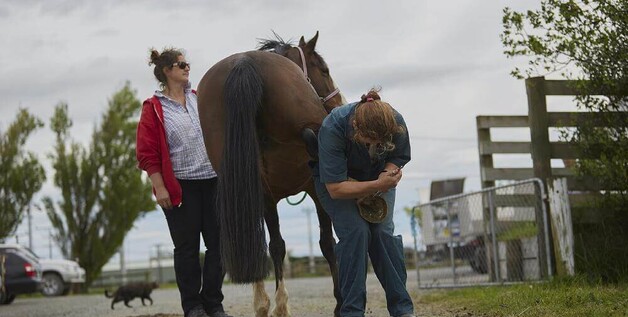We’ve all heard the saying ‘No foot, no horse’, and when it comes to the performance horse, this certainly holds true. It has been long known that when it comes to lameness in the horse, 90% of the time the lameness is in the foot. While this may be true, we also must remember that a large number of injuries occur higher in the limb as a result of poor hoof balance.
Horses have only one digit in each limb. They stand on the tips of the digit, balanced on a modified fingernail (the hoof capsule). In each of these digits, they have the same number of major bones (phalanges) as humans have in the middle finger, just a different shape and size.
When describing the hoof and foot of a horse, several terms are used. Palmar refers to the underside of the hoof (equivalent to the palm of the human hand (and plantar in the hind limb aka the plantar surface of the human foot). The opposite surface (which faces forwards) is referred to as the dorsal surface. Proximal refers to the regions that are located farther up the limb (i.e. closest to the body), and distal refers to regions that are located farther down the limb (i.e. furthest from the body) Medial refers to the side of the structure (bone, joint etc) that is closest to the midline of the body and lateral refers to the side farthest from the midline.
Many of you may have had an in-depth lameness examination performed on your horse. As part of this examination, we assess the shape and balance of your horse’s feet, the way it hits the ground stance and the loading phase) and the movement of foot through the air (swing phase).
Hoof Wall Shape
Interpretation of abnormal hoof wall shape can be quite useful but, like abnormal wear, can vary with more than one factor (e.g. conformation, trimming and shoeing practice, environment, nutrition and the presence or absence of problems within the hoof capsule). Generalised distortions for the hoof wall can be the result of foot conformation, foot imbalance problems, generalized white line disease or laminitis. Focal distortions of the hoof wall can occur as a result of a space-occupying lesions source as a keratoma or foreign body or underlying separation of the hoof wall (white line disease, laminitis, submural infection or mechanical structural damage.
Hoof Balance
The evaluation and interpretation of foot balance are thought of in terms of what can be most easily manipulated or changed. Controversy constitutes to exist as to what constitutes normal or ideal balance. To some extent, this depends on the discipline of the horse. Trotters for instance are different to a dressage horse or a showjumper, thereby altering the speed of the foot through the air and the length of a horse’s stride. At present, hoof balance is described in the two broad categories morphologic hoof balance and dynamic hoof balance. It is logical to assume that one influences the other. When assessing hoof balance, visual examination of the foot is conducted to appreciate the respective proportion of the foot (heels, quarter, and toe) to the total bearing surface. The ideal most frequently proposed is that of a symmetrical foot, which consists of the frog dividing the foot into equal medial and lateral aspects and a level bearing surface when viewed from heel to toe. Absolute symmetry is virtually nonexistent in nature, horses are not symmetrical nor should their feet be. When examining a horse’s foot, we have to be careful to consider what other abnormal forces do to influence the growth, distortion and wear of the foot. For instance, horses with less than ideal conformation are likely to have asymmetrical bearing surfaces. However, in some horses the weight-bearing surface may be in balance with a crooked or distorted limb, allowing the limb to more efficiently accept the forces of impact for a given conformation or swing pattern. Front to back balance is another aspect of overall foot balance and is generally described in terms of toe length and angle and heel depth and angle. The long toe / low heel foot conformation is undoubtedly a significant contributor to foot and limb disorders.
Along with visual assessment, radiographic assessment using standard surveying views (lateral-medial and dorso-palmar/ plantar views) are also helpful to guide future hoof trimming and shoe placement. Any underlying bone pathology can also be detected on radiographs which can help to guide the correct shoe type and fitting.
If you have any concerns about your horse’s foot balance or are concerned about performance issues or lameness that may be arising from hoof balance, please contact us at VetSouth Equine so we can arrange an appointment.
- Heather Busby

